Motorola Solutions 89FT4922 2-Way Portable Radio User Manual RF Safety Manual
Motorola Solutions, Inc. 2-Way Portable Radio RF Safety Manual
Contents
- 1. User Manual
- 2. RF Safety Manual
RF Safety Manual
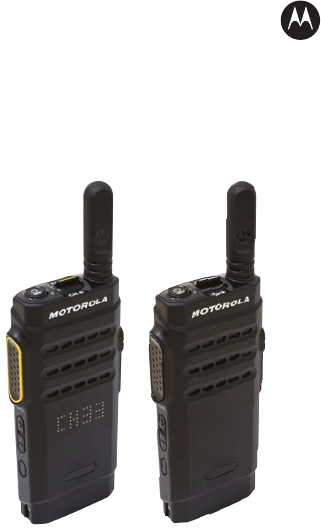
COMMERCIAL DIGITAL TWO-WAY RADIO
MOTOTRBO™
SL300
PORTABLE RADIOS
QUICK REFERENCE GUIDE

1English
Important Safety Information
RF Energy Exposure and Product Safety
Guide for Portable Two-Way Radios
ATTENTION!
This radio is restricted to Occupational use only.
Before using the radio, read the RF Energy Exposure
and Product Safety Guide for Portable Two-Way
Radios which contains important operating
instructions for safe usage and RF energy awareness
and control for Compliance with applicable standards
and Regulations.
For a list of Motorola-approved antennas, batteries,
and other accessories, visit the following website:
http://www.motorolasolutions.com/
MainContent_NAG-LACR.fm Page 1 Friday, September 5, 2014 10:59 AM

2
English
RF Energy Exposure Awareness and
Control Information and Operational
Instructions for Occupational Use
NOTICE: This radio is intended for use in
occupational/controlled conditions
where users have full knowledge of their
exposure and can exercise control over
their exposure to meet the occupational
limits in FCC and International
standards. This radio device is NOT
authorized for general population
consumer use.
This two-way radio uses electromagnetic energy in
the radio frequency (RF) spectrum to provide
communications between two or more users over a
distance. It uses radio frequency (RF) energy or radio
waves to send and receive calls. RF energy is one
form of electromagnetic energy. Other forms include,
but are not limited to, sunlight and x-rays. RF energy,
however, should not be confused with these other
forms of electromagnetic energy, which when used
improperly, can cause biological damage. Very high
levels of x-rays, for example, can damage tissues and
genetic material.
Experts in science, engineering, medicine, health, and
industry work with organizations to develop standards
for safe exposure to RF energy. These standards
provide recommended levels of RF exposure for both
workers and the general public. These recommended
RF exposure levels include substantial margins of
protection.
MainContent_NAG-LACR.fm Page 2 Friday, September 5, 2014 10:59 AM

3English
All Motorola two-way radios are designed,
manufactured, and tested to ensure they meet
government-established RF exposure levels. In
addition, manufacturers also recommend specific
operating instructions to users of two-way radios.
These instructions are important because they inform
users about RF energy exposure and provide simple
procedures on how to control it.
Please refer to the following websites for more
information on what RF energy exposure is and how
to control your exposure to assure compliance with
established RF exposure limits:
http://www.fcc.gov/oet/rfsafety/rf-faqs.html
www.who.int/en/
www.motorolasolutions.com/rfhealth
Federal Communication Commission
(FCC) Regulations
When two-way radios are used as a consequence of
employment, the FCC requires users to be fully aware
of and able to control their exposure to meet
occupational requirements. Exposure awareness can
be facilitated by the use of a product label directing
users to specific user awareness information. Your
Motorola two-way radio has a RF Exposure Product
Label. Also, your Motorola user manual, or separate
safety booklet includes information and operating
instructions required to control your RF exposure and
to satisfy compliance requirements.
MainContent_NAG-LACR.fm Page 3 Friday, September 5, 2014 10:59 AM

4
English
Compliance with RF Exposure Standards
Your Motorola two-way radio is designed and tested to
comply with a number of national and International
standards and guidelines (listed below) for human
exposure to radio frequency electromagnetic energy.
This radio complies with the IEEE (FCC) and
ICNIRP exposure limits for occupational/
controlled RF exposure environments at
operating duty factors of up to 50% talk-50% listen
and is approved for occupational use only. In
terms of measuring RF energy for compliance with
these exposure guidelines, your radio generates
measurable RF energy only while it is transmitting
(during talking), not when it is receiving (listening)
or in standby mode.
NOTE: The approved batteries, supplied with this
radio, are rated for a 5-5-90 duty factor (5%
talk-5% listen-90% standby) even though
this radio complies with FCC occupational
exposure limits and may operate at duty
factors of up to 50% talk.
Your Motorola two-way radio complies with the
following RF energy exposure standards and
guidelines:
• United States Federal Communications
Commission (FCC), Code of Federal Regulations;
47 CFR et seq. & FCC, OET Bulletin 65
• Institute of Electrical and Electronic Engineers
(IEEE) C95.1
• International Commission on Non-Ionizing
Radiation Protection (ICNIRP)
MainContent_NAG-LACR.fm Page 4 Friday, September 5, 2014 10:59 AM

5English
• Ministry of Health (Canada) Safety Code 6 &
Industry Canada RSS-102
• Australian Communications Authority
Radiocommunications Standard et seq.
• ANATEL ANNEX to Resolution No. 303 et seq.
RF Exposure Compliance and Control
Guidelines and Operating Instructions
for Two-Way Radio Operations
To control your exposure and ensure compliance with
the occupational/controlled environment exposure
limits, always adhere to the following procedures.
• DO NOT remove the RF Exposure Label from the
device.
• User awareness instructions should accompany
device when transferred to other users.
Two-Way Radio Operation
• Transmit no more than the rated duty factor of 50%
of the time. To transmit (talk), push the Push-To-
Talk (PTT) button. To receive calls, release the PTT
button. The PTT button may reside on the radio
itself or may be hosted on approved wired or
wireless (for example, a Bluetooth-enabled remote
PTT button) accessories. Transmitting 50% of the
time, or less, is important because this radio
generates measurable RF energy exposure only
when transmitting (in terms of measuring for
standards compliance).
MainContent_NAG-LACR.fm Page 5 Friday, September 5, 2014 10:59 AM

6
English
• In front of the face. Hold the radio in
a vertical position with the
microphone (and other parts of the
radio including the antenna) at least
one inch (2.5 centimeters) away from
the nose or lips. Keeping the radio at
a proper distance is important to ensure
compliance.
NOTE: RF exposures decrease with increasing
distance from the antenna.
• Body Worn Operation. When worn on the body,
always place the radio in a Motorola-approved clip,
holder, holster, case, or body harness for this
product. Using approved body-worn accessories is
important because the use of non-Motorola-
approved accessories may result in exposure
levels, which exceed the occupational/controlled
environment RF exposure limits.
• Use only Motorola-approved supplied or
replacement antennas, batteries, and audio
accessories. Use of non-Motorola-approved
antennas, batteries, and wired or wireless
accessories may exceed the applicable RF
exposure guidelines (iEEE, ICNIRP or FCC).
• For a list of Motorola-approved accessories for your
radio model, visit the following website: https://
www.motorolasolutions.com
MainContent_NAG-LACR.fm Page 6 Friday, September 5, 2014 10:59 AM

7English
Electromagnetic Interference/
Compatibility
NOTE: Nearly every electronic device is susceptible
to electromagnetic interference (EMI) if
inadequately shielded, designed, or
otherwise configured for electromagnetic
compatibility.
Facilities
To avoid electromagnetic interference and/or
compatibility conflicts, turn off your radio in any facility
where posted notices instruct you to do so. Hospitals
or health care facilities may be using equipment that is
sensitive to external RF energy.
Aircraft
When instructed to do so, turn off your radio when on
board an aircraft. Any use of a radio must be in
accordance with applicable regulations per airline
crew instructions.
Medical Devices
Pacemakers
The Advanced Medical Technology Association
(AdvaMed) recommends that a minimum separation
of 6 inches (15 centimeters) be maintained between a
handheld wireless radio and a pacemaker. These
recommendations are consistent with those of the
U.S. Food and Drug Administration.
MainContent_NAG-LACR.fm Page 7 Friday, September 5, 2014 10:59 AM

8
English
Persons with pacemakers should:
• ALWAYS keep the radio more than 6 inches
(15 centimeters) from their pacemaker when the
radio is turned ON.
• Not carry the radio in the breast pocket.
• Use the ear opposite the pacemaker to minimize
the potential for interference.
• Turn the radio OFF immediately if there is any
reason to suspect that interference is taking place.
Hearing Aids
Some digital wireless radios may interfere with some
hearing aids. In the event of such interference, you
may want to consult your hearing aid manufacturer to
discuss alternatives.
Other Medical Devices
If you use any other personal medical device, consult
the manufacturer of your device to determine if it is
adequately shielded from RF energy. Your physician
may be able to assist you in obtaining this information.
Use of Communication Devices While Driving
Always check the laws and regulations on the use of
radios in the areas where you drive.
• Give full attention to driving and to the road.
• Use hands-free operation, if available.
• Pull off the road and park before making or
answering a call, if driving conditions or regulations
so require.
MainContent_NAG-LACR.fm Page 8 Friday, September 5, 2014 10:59 AM

9English
Acoustic Safety
Exposure to loud noises from any source for extended
periods of time may temporarily or permanently affect
your hearing. The louder the radio's volume, the less
time is required before your hearing could be affected.
Hearing damage from loud noise is sometimes
undetectable at first and can have a cumulative effect.
To protect your hearing:
• Use the lowest volume necessary to do your job.
• Turn up the volume only if you are in noisy
surroundings.
• Turn down the volume before adding headset or
earpiece.
• Limit the amount of time you use headsets or
earpieces at high volume.
• When using the radio without a headset or
earpiece, do not place the radio's speaker directly
against your ear.
MainContent_NAG-LACR.fm Page 9 Friday, September 5, 2014 10:59 AM

10
English
Operational Warnings
For Vehicle With Air Bags:
Refer to vehicle manufacturer's
manual prior to installation of
electronic equipment to avoid
interference with air bag wiring.
DO NOT place a portable radio in the
area over an air bag or in the air bag
deployment area. Air bags inflate
with great force. If a portable radio is
placed in the air bag deployment
area and the air bag inflates, the
radio may be propelled with great
force and cause serious injury to
occupants of the vehicle.
Potentially Explosive
Atmospheres
(Explosive atmospheres refers to
hazard classified locations that may
contain hazardous gas, vapors, or
dusts.)
Turn off your radio prior to entering
any area with a potentially explosive
atmosphere unless it is a portable
radio type especially qualified for
use in such areas as Intrinsically
Safe (for example, Factory Mutual,
CSA, UL, or CENELEC).
W A R N I N G
MainContent_NAG-LACR.fm Page 10 Friday, September 5, 2014 10:59 AM

11 English
DO NOT remove, install, or charge
batteries in such areas. Sparks in a
potentially explosive atmosphere
can cause an explosion or fire
resulting in bodily injury or even
death.
The areas with potentially explosive
atmospheres referred to above
include fueling areas such as below
decks on boats, fuel or chemical
transfer or storage facilities, and
areas where the air contains
chemicals or particles such as
grain, dust or metal powders. Areas
with potentially explosive
atmospheres are often, but not
always, posted.
Blasting Caps and Blasting Areas
To avoid possible interference with
blasting operations, turn off your
radio when you are near electrical
blasting caps, in a blasting area, or
in areas posted: “Turn off two-way
radio.” Obey all signs and
instructions.
Operational Warnings (Continued)
W A R N I N G
MainContent_NAG-LACR.fm Page 11 Friday, September 5, 2014 10:59 AM

12
English
Operational Cautions
Antennas
DO NOT use any portable radio that has a
damaged antenna. If a damaged antenna
comes into contact with your skin, a minor
burn can result.
Batteries
All batteries can cause property damage
and/or bodily injury, such as burns, if a
conductive material such as jewelry, keys,
or beaded chains touches exposed
terminals. The conductive material may
complete an electrical circuit (short circuit)
and become quite hot. Exercise care in
handling any charged battery, particularly
when placing it inside a pocket, purse, or
other container with metal objects.
C a u t i o n
MainContent_NAG-LACR.fm Page 12 Friday, September 5, 2014 10:59 AM

13 English
m
SL300 Portable Radios
Quick Reference Guide
NOTE: For more details on your radio's operations/
features, refer to MOTOTRBO SL Series
SL300 Display/Non-Display Portables User
Guide (MN000895A01/MN000897A01)
MainContent_NAG-LACR.fm Page 13 Friday, September 5, 2014 10:59 AM
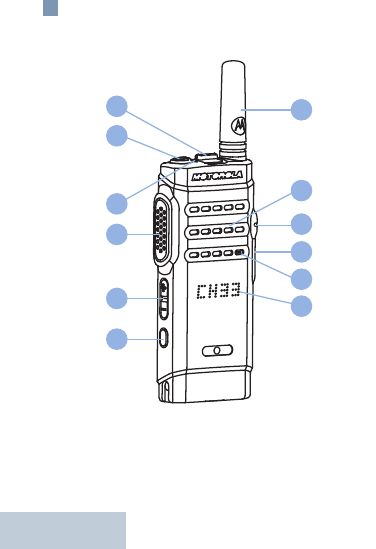
14
English
Radio Controls
Display Radio
6
1
5
4 10
12
11
9
2
3
8
7
MainContent_NAG-LACR.fm Page 14 Friday, September 5, 2014 10:59 AM
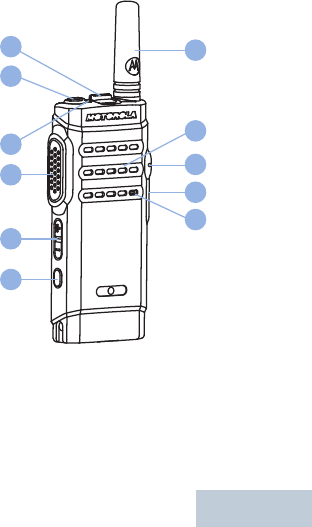
15 English
Non-Display Radio
6
1
5
4 10
12
11
9
2
3
8
MainContent_NAG-LACR.fm Page 15 Friday, September 5, 2014 10:59 AM

16
English
Record your radio’s programmable button functions in
the blanks provided. SP represents short press, LP
represents long press.
Display Radio: Channel Rocker
Non-Display Radio: Channel Selector Switch
On/Off/Information Button
LED Indicator
Push-to-Talk (PTT) Button
Volume Button
Side Button 1 (Programmable)
SP: ____________LP: ___________
Display
Microphone
USB Connector
Accessory Connector
Speaker
Antenna
1
2
3
4
5
6
7
8
9
10
11
12
MainContent_NAG-LACR.fm Page 16 Friday, September 5, 2014 10:59 AM

17 English
LED Indicator
Solid red – Radio is charging.
Blinking red – Radio is (1) transmitting at low battery
condition, (2) receiving an emergency transmission,
(3) indicating low battery charge when the On/Off/
Information button is pressed, (4) has failed the self-
test upon powering up, (5) has charging errors, or (6)
has moved out of range if radio is configured with
Auto-Range Transponder System.
Solid yellow – Radio is (1) monitoring a conventional
channel, or (2) indicating fair battery charge when the
On/Off/Information button is pressed.
Blinking yellow – Radio is (1) scanning for activity,
(2) receiving a Call Alert, or (3) the flexible receive list
is enabled.
Solid green – Radio is (1) powering up, (2) sending a
Call Alert or an emergency transmission, (3)
transmitting, or (4) indicating full battery charge when
the On/Off/Information button is pressed.
Blinking green – Radio is (1) receiving a call or data,
or (2) detecting activity over the air.
MainContent_NAG-LACR.fm Page 17 Friday, September 5, 2014 10:59 AM

18
English
Charging the Battery
Your radio is powered by a Lithium-Ion (Li-lon)
battery. To avoid damage and to ensure compliance
with warranty terms, charge the battery using a
Motorola charger exactly as described in the charger
user guide. All chargers can charge only Motorola
authorized batteries. Other batteries may not charge.
It is recommended your radio remains powered off
while charging.
Charge a new battery 14 to 16 hours before initial use
for best performance. Prior to charging a battery with
the radio, it is recommended to turn the radio off.
Batteries charge best at room temperature.
MainContent_NAG-LACR.fm Page 18 Friday, September 5, 2014 10:59 AM
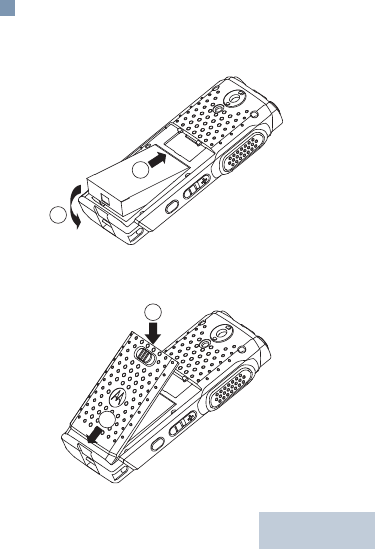
19 English
Attaching the Battery
Align the battery contacts with the contacts inside the
battery compartment. Insert the contact side of the
battery first. Gently push the battery into place.
To attach battery cover, align it in place and slide the
battery latch until it snaps into place. Slide battery
latch into lock position.
1
2
1
2
MainContent_NAG-LACR.fm Page 19 Friday, September 5, 2014 10:59 AM
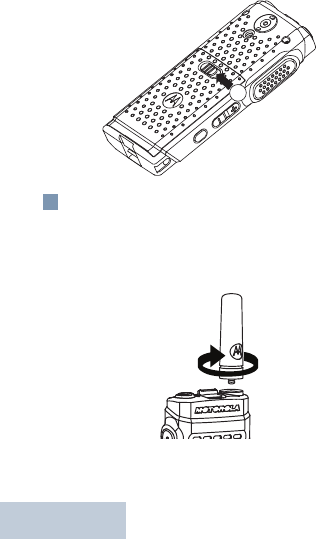
20
English
Attaching the Antenna
With the radio turned off, set the antenna in its
receptacle and turn clockwise.
Make sure that the antenna is tightened securely to
the radio.
To remove the antenna, turn the antenna
counterclockwise.
3
MainContent_NAG-LACR.fm Page 20 Friday, September 5, 2014 10:59 AM

21 English
Powering Up and Turning Off the
Radio
Short press the On/Off/Information button.
You see a power on animation for display radio. The
LED lights up solid green.
To turn off the radio, long press the On/Off/
Information button.
Adjusting the Volume
To increase the volume, press the Volume button up.
To decrease the volume, press the Volume button
down.
NOTE: Your radio can be programmed to have a
minimum volume offset where the volume
level cannot be turned down fully. Check
with your dealer or system administrator for
more information.
Accessing the Radio from Password
Follow the procedure below.
1. Power up the radio. You hear a continuous tone.
2. Push the Channel Rocker to enter the first digit of
the password.
MainContent_NAG-LACR.fm Page 21 Friday, September 5, 2014 10:59 AM

22
English
3. Press Side Button 1 to enter each digit of the
remaining three digits of the password. You hear a
positive indicator tone for each Side Button 1
press. When the second digit of the password is
entered, your radio ignores any push of the
Channel Rocker.
4. When the last digit of the four-digit password is
entered, your radio automatically checks the
validity of the password. If the password is correct,
your radio proceeds to power up.
OR
If the password is incorrect, you hear a continuous
tone. Repeat Steps 1 to 3.
Selecting a Channel
Push the Channel Rocker for display radio or
Channel Selector Switch for non-display radio to
select the channel.
Making a Group Call
Follow the procedure below.
1. Select the channel.
OR
Press the programmed One Touch Access
button.
2. Hold the radio vertically 1 to 2 inches (2.5 to 5.0
cm) from your mouth.
MainContent_NAG-LACR.fm Page 22 Friday, September 5, 2014 10:59 AM

23 English
3. Press the PTT button to make the call. The LED
lights up solid green. The display shows the group
call alias or ID for display radio.
4. Wait for the Talk Permit Tone to finish (if enabled).
5. Speak clearly into the microphone.
6. Release the PTT button to listen. When the target
radio responds, the LED blinks green. You see the
transmitting radio alias or ID on your display for
display radio.
7. If the Channel Free Indication feature is
enabled, you hear a short alert tone the moment
the transmitting radio releases the PTT button,
indicating the channel is free for you to respond.
Press the PTT button to respond.
OR
If there is no voice activity for a predetermined
period of time, the call ends. Radio returns to the
screen you were on prior to initiating the call.
To make a call to a group of users, your radio must be
configured as part of that group.
MainContent_NAG-LACR.fm Page 23 Friday, September 5, 2014 10:59 AM

24
English
Making a Private Call
NOTE: Your radio must be programmed for you to
initiate a Private Call.
Follow the procedure below.
1. Select the channel with the active subscriber alias
or ID.
OR
Press the programmed One Touch Access but-
ton.
2. Hold the radio vertically 1 to 2 inches (2.5 to 5.0
cm) from your mouth.
3. Press the PTT button to make the call. The LED
lights up solid green. The display shows the
subscriber alias or ID for display radio.
4. Wait for the Talk Permit Tone to finish (if enabled).
5. Speak clearly into the microphone.
6. Release the PTT button to listen. When the target
radio responds, the LED blinks green.
7. If the Channel Free Indication feature is
enabled, you hear a short alert tone the moment
the transmitting radio releases the PTT button,
indicating the channel is free for you to respond.
Press the PTT button to respond.
OR
If there is no voice activity for a predetermined
period of time, the call ends. You hear a short tone.
MainContent_NAG-LACR.fm Page 24 Friday, September 5, 2014 10:59 AM

25 English
Making a Selective Call
NOTE: Your radio must be programmed for you to
initiate a Selective Call.
Follow the procedure below.
1. Select the channel with the active subscriber alias
or ID.
2. Hold the radio vertically 1 to 2 inches (2.5 to 5.0
cm) from your mouth.
3. Press the PTT button to make the call. The LED
lights up solid green.
4. Wait for the Talk Permit Tone to finish (if enabled).
5. Speak clearly into the microphone.
6. Release the PTT button to listen. When the target
radio responds, the LED blinks green.
7. If the Channel Free Indication feature is
enabled, you hear a short alert tone the moment
the transmitting radio releases the PTT button,
indicating the channel is free for you to respond.
Press the PTT button to respond.
OR
If there is no voice activity for a predetermined
period of time, the call ends.
MainContent_NAG-LACR.fm Page 25 Friday, September 5, 2014 10:59 AM

26
English
Starting and Stopping Scan
Press the programmed Scan button.
OR
Use the Channel Rocker for display radio or
Channel Selector Switch for non-display radio to
select a channel programmed with Auto Scan
enabled.
When Scan is enabled, the LED blinks yellow and you
hear a positive indicator tone.
When Scan is disabled, the LED turns off and you
hear a negative indicator tone.
To stop a scan, press the programmed Scan button.
Making a Call Alert
Press the programmed One Touch Access button to
make a Call Alert to the predefined alias or ID. The
display shows ALERT for display radio. The LED lights
up solid green when your radio is sending the Call
Alert.
If the Call Alert acknowledgement is received, a tone
sounds and the display shows positive indicator for
display radio.
If the Call Alert acknowledgement is not received, a
tone sounds and the display shows negative indicator
for display radio.
MainContent_NAG-LACR.fm Page 26 Friday, September 5, 2014 10:59 AM

27 English
Sending an Emergency Alarm
Press the programmed Emergency On button. The
display shows ALRM and the destination alias for
display radio.
When an Emergency Alarm acknowledgement is
received, the Emergency tone sounds and the LED
blinks green.
If your radio does not receive an Emergency Alarm
acknowledgement, and after all retries have been
exhausted, a tone sounds.
Radio exits the Emergency Alarm mode.
Voice Announcement
Press the programmed Voice Announcement button
to toggle voice announcement on or off.
MainContent_NAG-LACR.fm Page 27 Friday, September 5, 2014 10:59 AM

28
English
NOTES
MainContent_NAG-LACR.fm Page 28 Friday, September 5, 2014 10:59 AM

*MN000902A01*
MN000902A01-A
Motorola Solutions, Inc.
1303 East Algonquin Road
Schaumburg, Illinois 60196 U.S.A.
MOTOROLA, MOTO, MOTOROLA SOLUTIONS and the Stylized
M logo are trademarks or registered trademarks of Motorola
Trademark Holdings, LLC and are used under license. All other
trademarks are the property of their respective owners.
MOTOROLA, MOTO, MOTOROLA SOLUTIONS et le logotype
au M stylisé sont marques de commerce ou marques déposées
de Motorola Trademark Holdings LLC, et sont utilisées sous
licence. Toutes les autres marques de commerce sont la
propriété de leurs titulaires respectifs.
© 2014 Motorola Solutions, Inc. All rights reserved.
September 2014
www.motorolasolutions.com/mototrbo
Printed in the U.S.A.
M